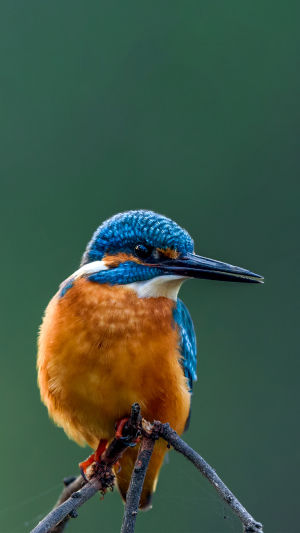Birds of the genus Kingfisher are medium-sized water birds. It is commonly known as the kingfisher because of the bright blue feathers on its back and face.
The following is an introduction to the kingfisher from several hair aspects.
Habitat
The kingfisher inhabits small rivers, streams, lakes, and irrigation canals where there is forest and water which is clear and slow flowing. They are solitary and usually perch alone on branches or rocks near the water's edge, waiting for an opportunity to hunt. They usually eat small fish, crustaceans, and a variety of aquatic insects and their larvae, as well as tiny frogs and a few aquatic plants.
The kingfisher can maintain excellent eyesight once it has entered the water, as its eyes can quickly adjust to the contrast in perspective caused by the light in the water. This is why it is such a good angler.
Habitat
The kingfisher inhabits small rivers, streams, lakes, and irrigation canals where there is forest and water which is clear and slow flowing. They are solitary and usually perch alone on branches or rocks near the water's edge, waiting for an opportunity to hunt. They usually eat small fish, crustaceans, and a variety of aquatic insects and their larvae, as well as tiny frogs and a few aquatic plants.
The kingfisher can maintain excellent eyesight once it has entered the water, as its eyes can quickly adjust to the contrast in perspective caused by the light in the water. This is why it is such a good angler.
Here are some common species of kingfisher.
Three-toed Kingfisher
The three-toed kingfisher has only three toes and a short tail but a long, pointed beak. The three-toed kingfisher is small but has brilliant blue or green bright plumage.
Spotted Wood Emerald
It has slightly dark wings and back. Orange-red forehead with extensive black eye stripes and bright blue whiskers.
Silver Kingfisher
The Silver Kingfisher is a small kingfisher, about 14 cm long, with mainly black and white plumage. It has silvery white spots on the black head and wings as well as silvery white on the throat and belly. The plumage on the breast is slightly blackish-blue, and they have showy body plumage, often with a blue or greenish glow.
Blue-breasted Kingfisher
The Blue-breasted Kingfisher is a solitary bird, mainly found in scrub or open forests, clear and slow-flowing rivers, streams, and lakes.
Red Emerald
In the light of a clear, cloudy day, the Red Emerald's body plumage is saturated and bright with a rich purple glow, looking more like a purple emerald.
Sulla Blue-eared Kingfisher
The Sula Blue-eared Kingfisher has a lilac antelope skin colour on its brow, throat, and breast, and a sharp, long, thick, reddish-brown bill. The tail is long and the wings are short.
Blue-eared Kingfisher
The Blue-eared Kingfisher resembles the Common Kingfisher in appearance, with a different blue upper body to the green of the Common Kingfisher and without the orange through-eye pattern of the Common Kingfisher.
The male and female are distinguished by their beaks, the lower part of the female being red, while the male is all black.
Common Kingfisher
The Common Kingfisher is the most typical and common type of kingfisher, small in size with a blue-green upper body with a blue band running down the middle and an orange-brown lower body. They live along seashores and waterways and are agile and patient, feeding on fish.
White-collared emerald
The white-collared emerald has a bright blue-green head, wings, back, and tail. It has a white spot on the upper part of the mouth, a white neck, and a white or beige underbody. The white neck is their most iconic physical feature.
White-breasted Jadeite
The White-breasted Jadeite is also known as the White-throated Jadeite.
They have a white chin, throat, and thorax, with a reddish, stout, and pointed beak. The head, neck, and belly are maroon in colour.





